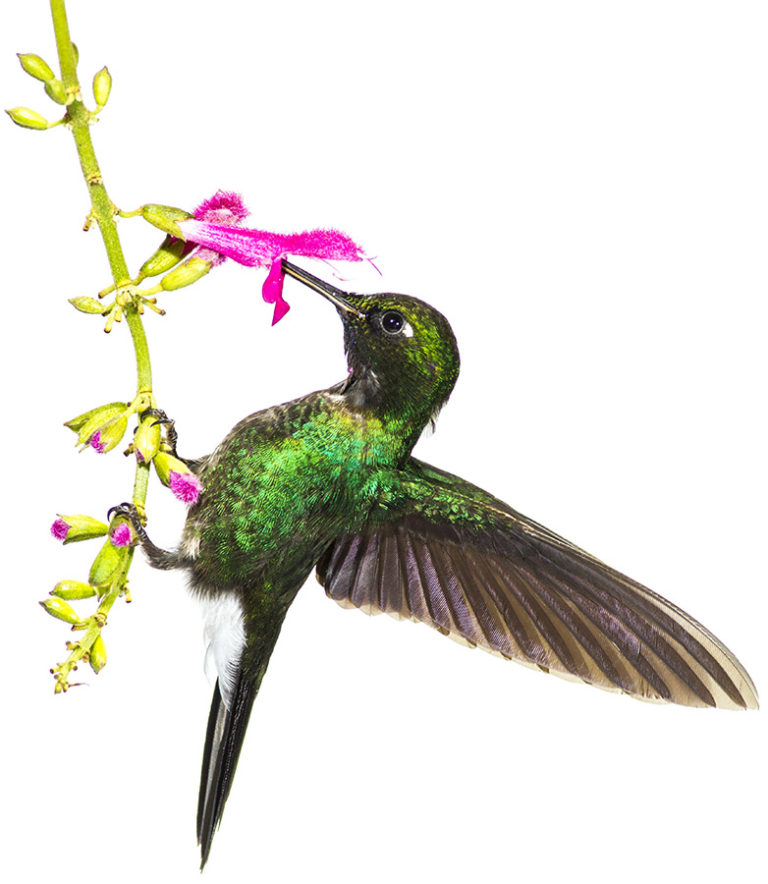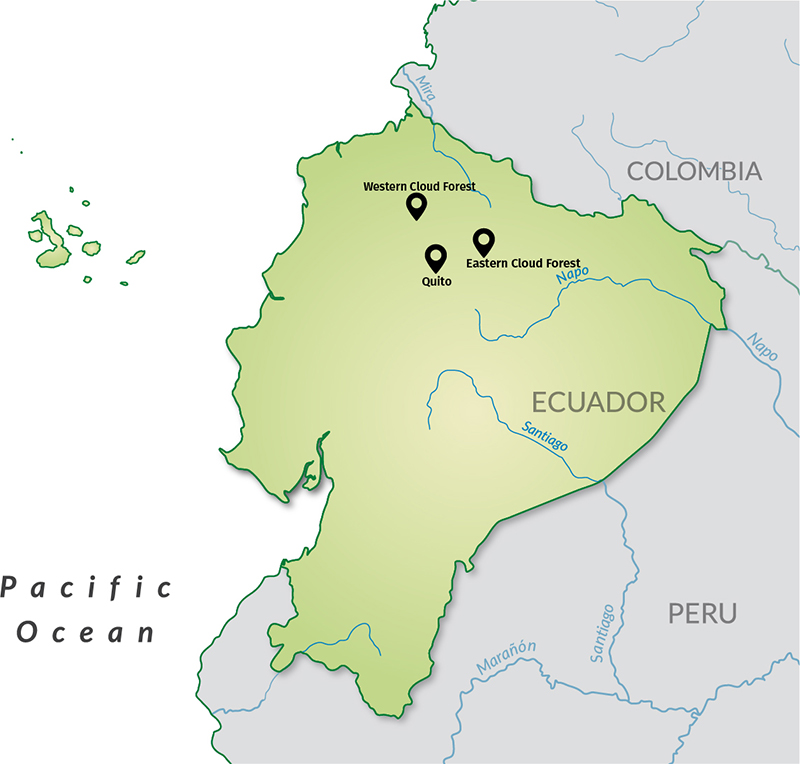About the Photo Tour
Knowing the Ecuadorian cloud forests, considered among the most biodiverse places in the region for their amazing flora and fauna, is a fascinating experience. We will travel through surprising and beautiful places that will give us endless opportunities to know this natural wealth through our photos.
On this photography tour through the Ecuador Cloud Forests, we can enjoy from the magical flutter of dozens of species of hummingbirds in Mindo, to the hypnotic singing of the Cock of the Rock.

Date
10 -21 Marzo 2020
Activity level
Moderado
Available spaces
Moderado
About the route
Daniel Mideros
Born in Ecuador. Professional photographer graduated in Advertising Communication and Marketing at the Universidad San Francisco de Quito. From an early age he showed a fascination with nature, photography and outdoor activities.
In his professional life he has dedicated himself mainly to the field of ecotourism, linked to visual communication and sustainability. This has led him to tour majestic places and feel unique experiences; all this emotional, experiential energy prompted him to undertake his own project with the desire to share these places and adventures with more people.
Javier Zurita
Born in Ecuador, Javier graduated from Tourism and Conservation at the Technical Equinoctial University of Quito (UTE). He is a nature photographer, specialized in birds and high speed.
He currently works as an expert photographer guide, in addition to the adaptation of bird feeders and the development of photographic hiding places, commonly called “hide”.

Early in the morning we will embark on our trip to the high cloud forest area.
We will make our first stop in the parish of Nono, where we will seek, within a hide, to photograph the emblematic tororoi birds or ampitas, among which are the Chestnut-naped Antpitta (Grallaria nuchalis), Chestnut-crowned Antpitta (Grallaria ruficapilla) and Rufous Antpitta (Grallaria rufula); Then we will look to take pictures of the air dancers, the hummingbirds, among which we have: Buff-winged Starfrontlet (Coeligena lutetiae), Black-tailed Trainbearer (Lesbia victoriae), Sapphire-vented Puffleg (Eriocnemis luciani), Great Sapphirewing (Pterophanes cyanopterus), Collared Inca (Coeligena torquata), and the famous Sword-billed Hummingbird (Ensifera ensifera).
Once our photographs have been achieved, we will go to a site in search of the highland tanagers, we will look for the Scarlet-bellied Mountain Tanager (Anisognathus igniventris), Black-chested Mountain Tanager (Buthraupis eximia), Hooded Mountain Tanager (Buthraupis montana), the Andean Guan (Penelope montagnii), Rufous-naped Brush Finch (Atlapetes latinuchus), among others.
After lunch we will go down to the Nanegalito area, where we will stop at a site with a great diversity of hummingbirds; in this place you can take very nice photos of hummingbirds perched on branches, among which we have: the Booted racket-tail (Ocreatus underwoodii), Fawn-breasted Brillant (Heliodoxa rubinoides), Purple-throated Woodstar (Calliphlox mitchelli), among others. In addition, birds such as the Crimson-rumped Toucanet (Aulacorhynchus haematopygus), Red-headed Barbet (Eubucco bourcierii), orioles and several species of tanagers usually arrive.
In the morning we will go to a hiding place or “hide”, where we will look to make images of the Masked Trogon (Trogon personatus), Plate-billed Mountain Toucan (Andigena laminirostris), Masked Flowerpiercer (Diglossa cyanea), several species of tanagers such as the Golden Tanager (Tangara arthus), Flame-faced Tanager (Tangara parzudakii), Black-capped Tanager (Tangara heinei), Blue-winged Mountain Tanager (Anisognatus somptuosus), Sickle-winged Guan (Chamaepetes goudtii), and other bird species.
In the afternoon, we will take high-speed photography; on this site you can find the Violet-tailed Sylph (Aglaiocercus coelestis), Booted racket-tail (Ocreatus underwoodii), Gorgeted Sunangel (Heliangelus strophianus), Empress Brillant (Heliodoxa imperatrix), among others.
After breakfast we will go to a transition zone between the Cloud Forest with the biodiverse Chocó Forest (1,700 to 750 meters above sea level), where we will look for birds such as the Glistening-greed Tanager (Chlorochrysa phoenicotis), Black-chinned Mountain Tanager (Anisognathus notabilis), Golden-naped Tanager (Tangara ruficervix), Moss-back Tanager (Bangsia edwardsi), Rufous-throated Tanager (Tangara rufigula), Orange-bellied Euphonia (Euphonia xanthogaster), among others.
If luck accompanies us, we will see other bird species such as the Orange-breasted Fruiteater (Pipreola jucunda), and the Toucan Barbet (Semnornis ramphastinus) that usually arrive.
Today, our objective is one of the most emblematic birds of the Cloud Forest, the Cock of the Rock (Rupicola peruviana). The males are concentrated in places called Lek, where, in a duel of songs and dances, they court the females who will choose the highest bidder as their reproductive partner.
NOTE: For this event it is very important to have patience and stealth, since we will be very close to the Lek, a sensitive place. Respect for these animals will be our priority.
After this show, we will see amazing birds that leave the forest to feed, among which are the Chestnut-crowned Antpitta (Grallaria ruficapilla), Giant Antpitta (Grallaria gigantea), Moustached Antpitta (Grallaria alleni), Dark-backed Wood Quail (Odontophorus melanonotus), among others.
In the afternoon, we will do high speed photography.
After breakfast, we will go to another place where we will take our last photographs of the Cloud Forest and its beautiful species, we will be able to observe the Pale-mandibled Aracari (Pteroglossus erythropygius), Green Honeycreeper (Chlorophanes spiza), Roufus-throated Tanagerb (Tangara rufigula), and if we are lucky the Chestnut-mandibled Toucan (Ramphastos swainsonni), Chocó Tucán (Ramphastos brevis) and Club-winged Manakin (Machaeropterus deliciosus).
Once this event is finished we will undertake our trip to the capital of the country, Quito.
We start the day from Quito to the Antisana Ecological Reserve.
Already in the heart of the park, our objective will be to photograph the Carunculated Caracara (Phalcoboenus carunculatus), nice raptors with colorful faces and mottled vest. Also the Bandurrias or Black-faced Ibis (Theristicus melanopis), very long-beaked birds that, unlike Caracara, are not as friendly to humans.
In this area is the Giant Hummingbird (Patagona gigas), the largest in the world! Also the Black-tailed Trainbearer (Lesbia victoriae), Sparkling Violetear (Colibrí coruscans), among others.
If we are lucky, we can see the Andean Condor (Vultur gryphus) flying over the valleys.
Once this tour is over, we will go to the Eastern Cloud Forest, where we will enjoy a delicious dinner at the lodge, a very homely place.
During this day, the Cloud Forest of the East will be our home. We will seek to photograph the famous Sword-billed Hummingbird (Ensifera ensifera) the bird with the longest beak in relation to the size of its body, the Masked Flowerpiercer (Diglossa cyanea), Long-tailed Sylph (Aglaiocercus kingi), the Collared Inca (Coeligena torquata ), Tyrian Metaltaild (Metallura Tyrianthina), Turquoise Jay (Cyanolyca Turcosa), Green Jay (Cyanocorax Yncas), Hooded Mountain Tanager (Buthraupis montana) and, with a bit of luck, the Torrent duck (Merganetta armata).
After breakfast we will go to Cayambe Coca Reserve. Where we looking for photograph birds such as the Tawny Antpitta (Grallaria quitensis), Bar-winged Cinclodes (Cinclodes fuscus), Black-backed Bush Tanager (Urothraupis stolzmanni), Rufous-bellied Seedsnipe (Attagis gayi), Red-crested Cotinga (Ampelion rubrocristatus), Black-chested Buzzard-eagle (Geranoaetus melanoleucus), among others.
Once this event is over, we will start our return trip to Quito.
In the Cloud Forest region we will have a mild climate and sometimes cold nights.
For a better experience, it is important to know a couple of factors which will facilitate your stay in Ecuador:
If you’d like to take home a couple of souvenirs, we recommend bringing a little extra cash in order to acquire these at the different locations we will be staying at (Ecuador’s currency is the US dollar). Most places only take cash. We recommend bringing small bills or coins, as most places do not accepts bills larger than $20.
The tropical regions have a lot of mosquitos, so bringing mosquito repellent is very important.
Sunblock.
Hats.
Flashlight (a headlamp is preferable).
Bags to store wet clothes.
Water bottle.
- Macro lens
- Wide angle lens
- Zoom lens, range 100-600
- Equipment protector for the rain
- Tripod
- Flash
- Batteries
- Battery chargers
- Cleaning equipment
- Plug adaptor
Accommodation.
All tour meals.
Expert photographer guide.
Private transfer.
Multi-flash.
Reserves fees.
International, National air tickets and airport taxes.
Additional nights.
Quito Hotel.
Alcoholic beverages, snacks and drinks that are not part of the meals.
Laundry service.
Personal expenses.
Tips.
Any other service not specified in the document.
Featured Sightings

Birds

